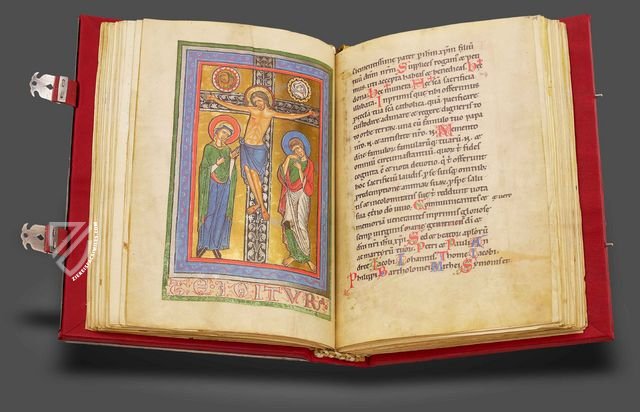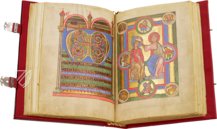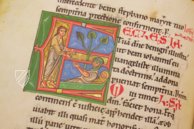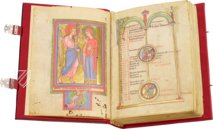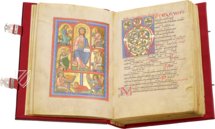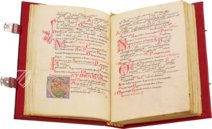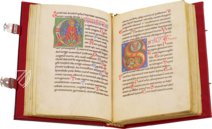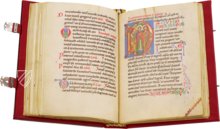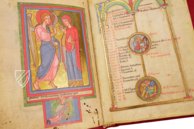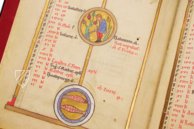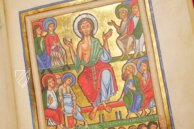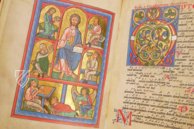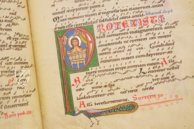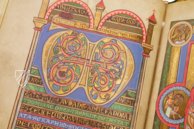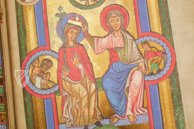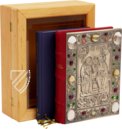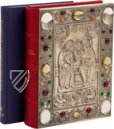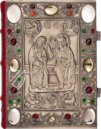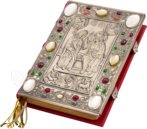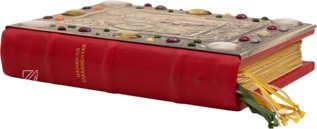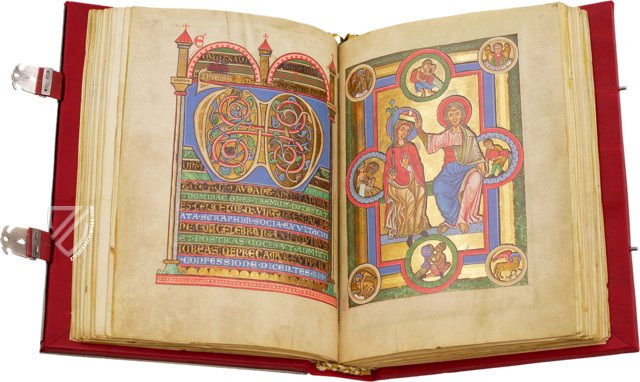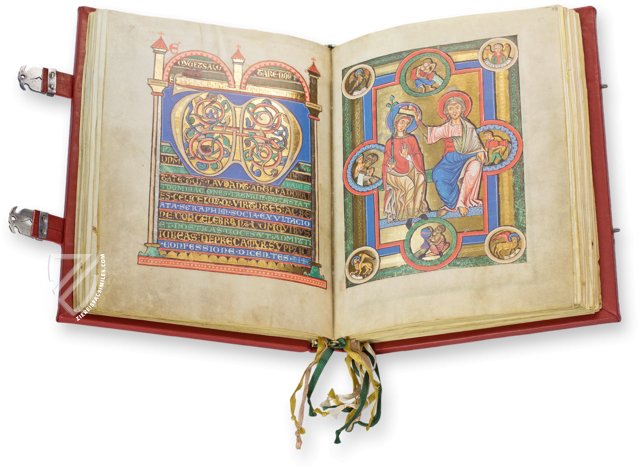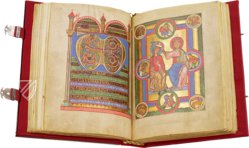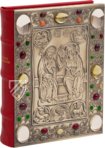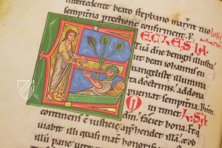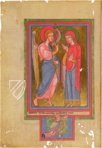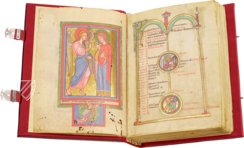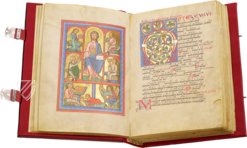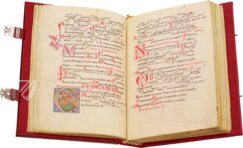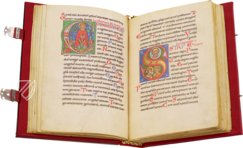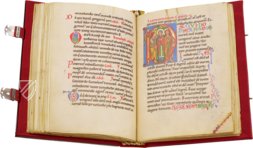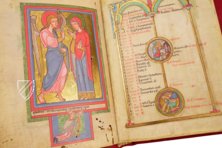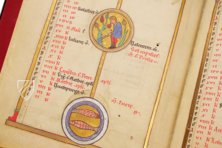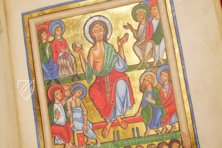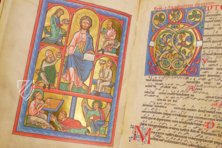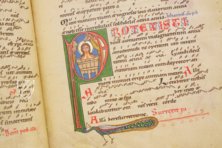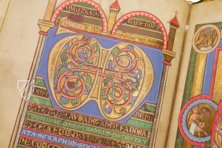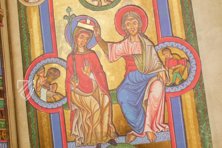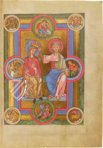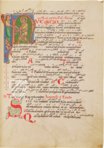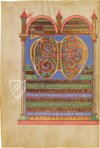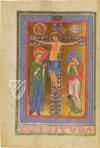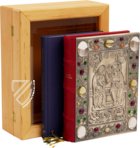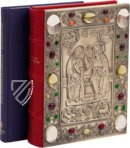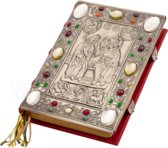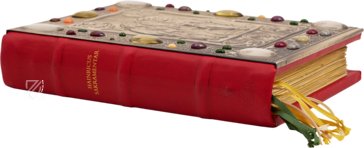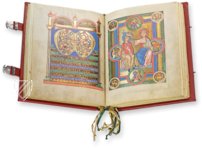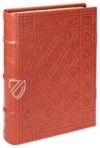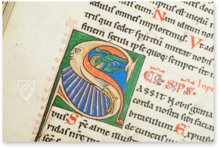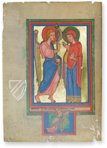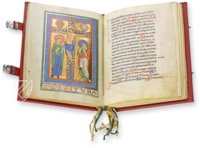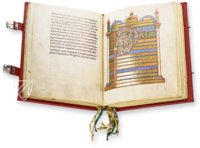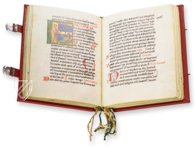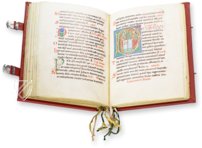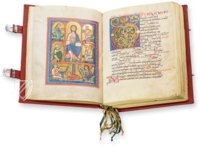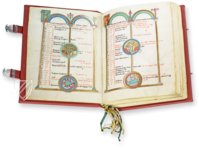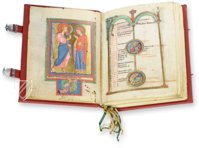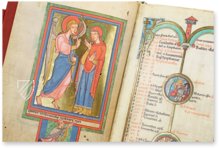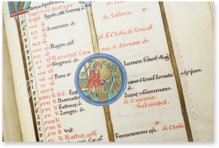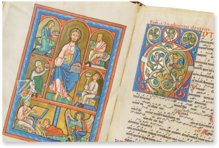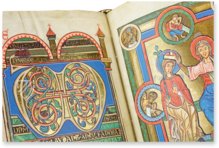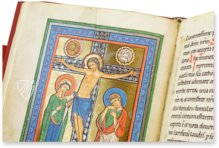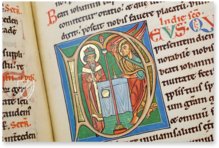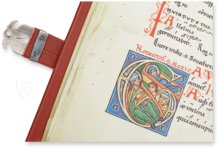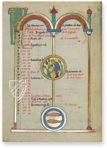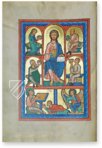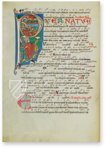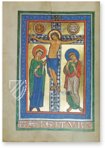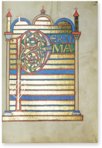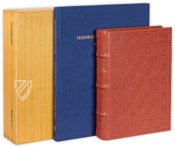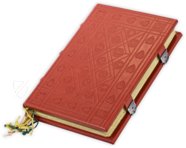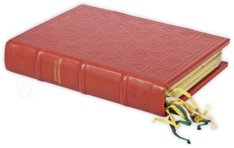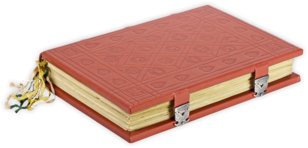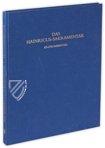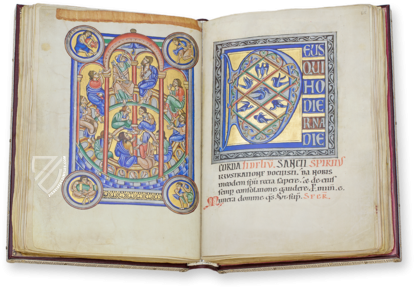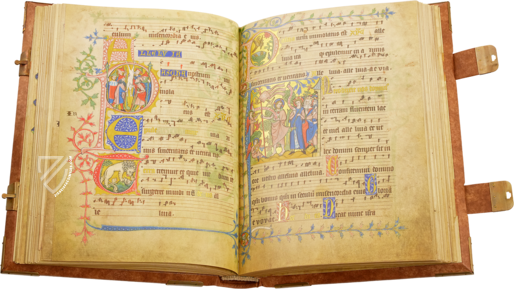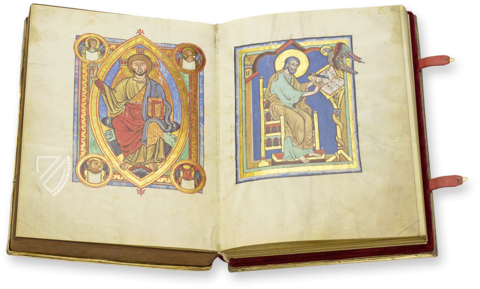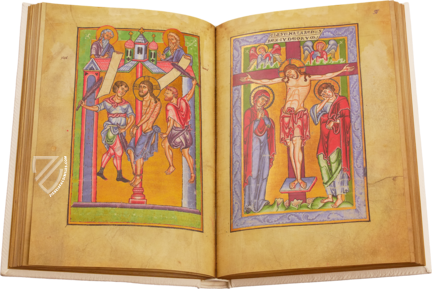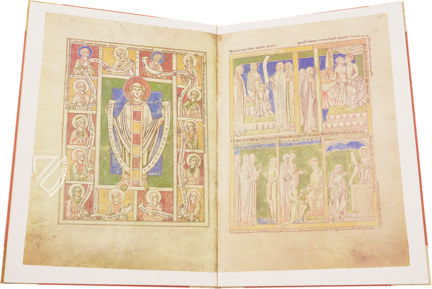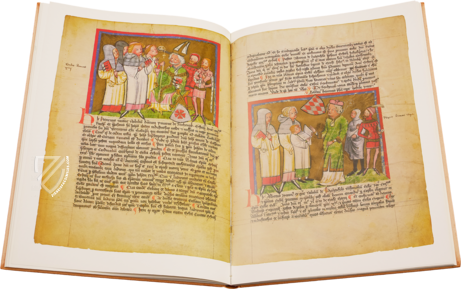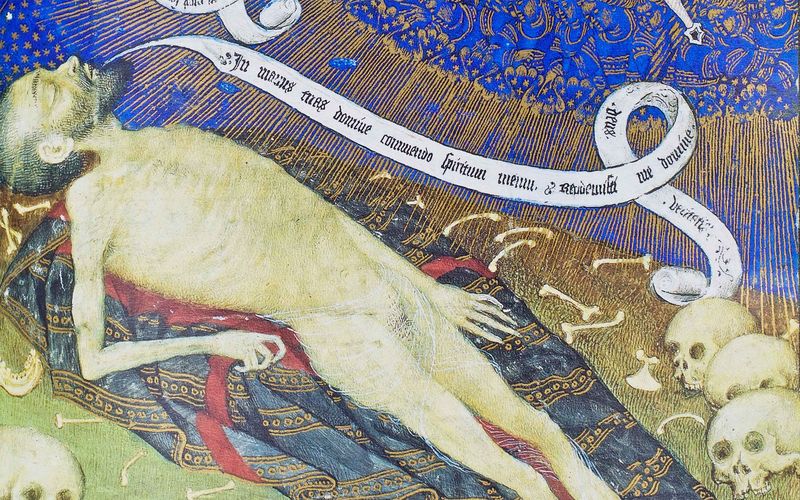Hainricus Missal
(over 10,000€)
This missal, which is one of the most beautiful of the German Romanesque period, was created thanks to the art-loving Abbot Berthold of Weingarten Monastery. He patronized the scriptorium there at the beginning of the 13th century to such an extent that a center of German illumination was formed where the most precious art treasures could be created including this missal created by the monk Hainricus. Although his exact identity will probably never be fully clarified, it is certain that Hainricus portrayed himself on the silver plate of the binding and in five other miniatures – a highly unusual circumstance. The book decoration is as magnificent as it is subtle: five splendid full-page miniatures, two-illuminated text pages, 24 calendar medallions, 35 historiated initials, and countless smaller color initials: this is the Hainricus Missal, which delights with its subtle splendor.
Hainricus Missal
Man's wish to stay in the memory of coming generations through the production of special works of art is one of the oldest. To be able to own such significant treasures is surely one of the greatest joys one can have. The history of this manuscript begins in 1217, when it was created in Weingarten Abbey, where it would stay for almost 600 years before being acquired by the first Earl of Leicester. His grandson, however, had to sell the codex to the millionaire John Pierpont Morgan Jr. a hundred years later. The ambitious abbot Berthold, who had great appreciation for art, sponsored the scriptorium of the Benedictine Abbey of Weingarten. Besides the Berthold Sacramentary, it is this manuscript above all that has caused the lasting fame of the great Weingarten school: the Hainricus Missal. Even so, the secret of Hainricus and his role in the production of the codex remain unexplained. According to the chronicle of the Weingarten Abbey, three monks carried this name – which one of them now is the Hainricus eternalized on the silver plate on the binding?
A Highlight of German Romanesque
Five magnificent full-page miniatures, two full-page ornamented initials, twenty-four calendar medallions, thirty-five narrative initials, twenty animal and scrollwork initials, and countless colored initials all executed in the highest perfection: this is the Hainricus Missal. The full-page miniatures, with fabulous frames carried out like panel paintings, captivate through their impressive monumentality. The initials present biblical episodes in a most lively manner. This high quality of decoration equals the precision with which the writing and neumes are carried out. Protagonists have overcome the rigor of their isolation and their emotions are within reach even though facial expressions and gestures are reduced to the basics. The Hainricus Master kicked off a great new artistic movement in the Weingarten scriptorium.
Codicology
- Alternative Titles
- Das Hainricus-Missale
Hainricus Sakramentar
Heinricus-Sakramentar - Size / Format
- 296 pages / 24.2 × 17.2 cm
- Origin
- Germany
- Date
- Ca. 1217
- Epochs
- Style
- Genre
- Language
- Script
- Gothic
- Illustrations
- 5 full-page miniatures, 2 illuminated text pages, 24 calendar medallions, 35 historiated initials, and countless smaller initials
- Content
- A liturgical book containing all instructions and texts necessary for the celebration of Mass throughout the year
- Artist / School
- The Hainricus Master
- Previous Owners
- Abbey of St. Peter's, Salzburg
Thomas William Coke, 1st Earl of Leicester (1754–1842)
J. P. Morgan Jr. (1867-1943)
Hainricus Missal
Crucifixion
Here we see a Crucifixion scene which is both typical for Gothic art but also exceptional for its artistry and the quality of its materials, e.g. the cross is constructed of silver vines. All the elements one expects are found here: the crowd has been reduced to just the Virgin Mary and John the Evangelist; the sun and moon are shown to symbolize the darkening of the heavens that occurred at the moment of Christ’s death. They have grieving human faces – the sun male and the moon female.
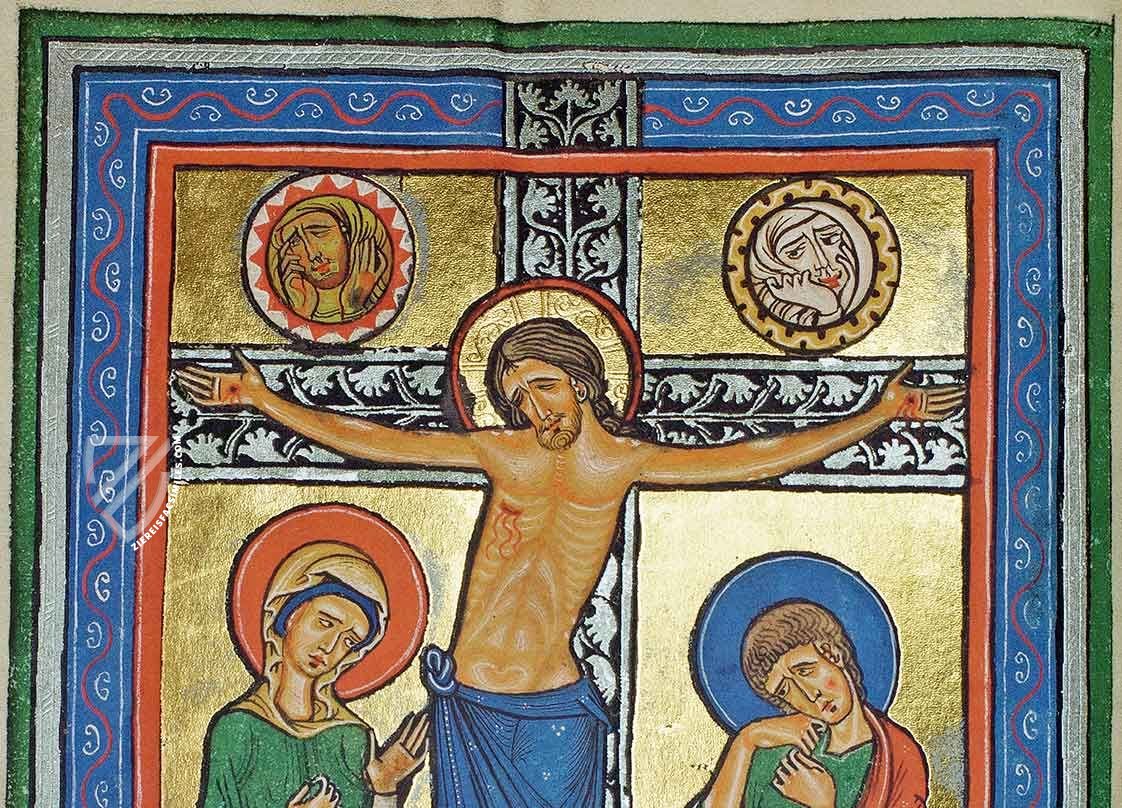
Hainricus Missal
Adoration by the Elders
Assembled around the Throne of God, the 24 elders described in Rev. 4:1–5 are represented here by four figures holding up their crowns. In the lower register, the text’s author John is pictured at a writing table, while the tonsured figure prostrating himself before John is labelled in silver as HAINRICVS, the mysterious figure after whom the manuscript is named.
This is an exemplary German Romanesque miniature with restrained gestures, calm, even serene facial expressions, and finely shaded primary colors. A certain angularity in the fall of folds already points to the nascent Zackenstil, the “jagged style” unique to the early German Gothic. A brilliantly burnished Byzantine style background rounds out this masterpiece.
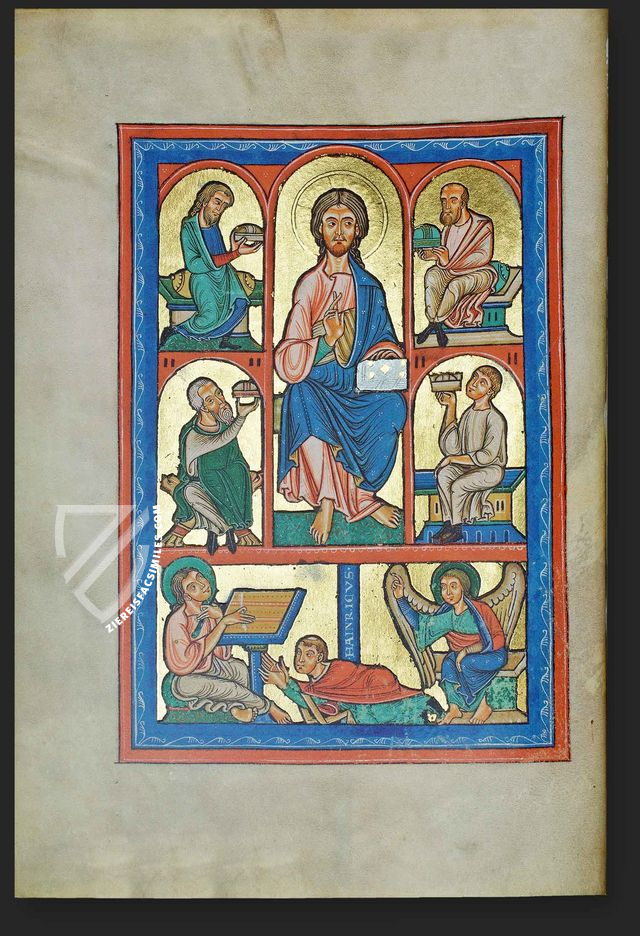
#1 Hainricus-Missale (Luxury Edition)
Language: German
(over 10,000€)
#2 Hainricus-Missale (Normal Edition)
(3,000€ - 7,000€)
- Treatises / Secular Books
- Apocalypses / Beatus
- Astronomy / Astrology
- Bestiaries
- Bibles / Gospels
- Chronicles / History / Law
- Geography / Maps
- Saints' Lives
- Islam / Oriental
- Judaism / Hebrew
- Single Leaf Collections
- Leonardo da Vinci
- Literature / Poetry
- Liturgical Manuscripts
- Medicine / Botany / Alchemy
- Music
- Mythology / Prophecies
- Psalters
- Other Religious Books
- Games / Hunting
- Private Devotion Books
- Other Genres
- Afghanistan
- Armenia
- Austria
- Belgium
- Belize
- Bosnia and Herzegovina
- China
- Colombia
- Costa Rica
- Croatia
- Cyprus
- Czech Republic
- Denmark
- Egypt
- El Salvador
- Ethiopia
- France
- Germany
- Greece
- Guatemala
- Honduras
- Hungary
- India
- Iran
- Iraq
- Israel
- Italy
- Japan
- Jordan
- Kazakhstan
- Kyrgyzstan
- Lebanon
- Liechtenstein
- Luxembourg
- Mexico
- Morocco
- Netherlands
- Palestine
- Panama
- Peru
- Poland
- Portugal
- Romania
- Russia
- Serbia
- Spain
- Sri Lanka
- Sweden
- Switzerland
- Syria
- Tajikistan
- Turkey
- Turkmenistan
- Ukraine
- United Kingdom
- United States
- Uzbekistan
- Vatican City
- A. Oosthoek, van Holkema & Warendorf
- Aboca Museum
- Ajuntament de Valencia
- Akademie Verlag
- Akademische Druck- u. Verlagsanstalt (ADEVA)
- Aldo Ausilio Editore - Bottega d’Erasmo
- Alecto Historical Editions
- Alkuin Verlag
- Almqvist & Wiksell
- Amilcare Pizzi
- Andreas & Andreas Verlagsbuchhandlung
- Archa 90
- Archiv Verlag
- Archivi Edizioni
- Arnold Verlag
- ARS
- Ars Magna
- ArtCodex
- AyN Ediciones
- Azimuth Editions
- Badenia Verlag
- Bärenreiter-Verlag
- Belser Verlag
- Belser Verlag / WK Wertkontor
- Benziger Verlag
- Bernardinum Wydawnictwo
- BiblioGemma
- Biblioteca Apostolica Vaticana (Vaticanstadt, Vaticanstadt)
- Bibliotheca Palatina Faksimile Verlag
- Bibliotheca Rara
- Boydell & Brewer
- Bramante Edizioni
- Bredius Genootschap
- Brepols Publishers
- British Library
- C. Weckesser
- Caixa Catalunya
- Canesi
- CAPSA, Ars Scriptoria
- Caratzas Brothers, Publishers
- Carus Verlag
- Casamassima Libri
- Centrum Cartographie Verlag GmbH
- Chavane Verlag
- Christian Brandstätter Verlag
- Circulo Cientifico
- Club Bibliófilo Versol
- Club du Livre
- CM Editores
- Collegium Graphicum
- Collezione Apocrifa Da Vinci
- Comissão Nacional para as Comemorações dos Descobrimentos Portugueses
- Coron Verlag
- Corvina
- CTHS
- D. S. Brewer
- Damon
- De Agostini/UTET
- De Nederlandsche Boekhandel
- De Schutter
- Deuschle & Stemmle
- Deutscher Verlag für Kunstwissenschaft
- DIAMM
- Droz
- E. Schreiber Graphische Kunstanstalten
- Ediciones Boreal
- Ediciones Grial
- Ediclube
- Edições Inapa
- Edilan
- Editalia
- Edition Deuschle
- Edition Georg Popp
- Edition Leipzig
- Edition Libri Illustri
- Editiones Reales Sitios S. L.
- Éditions de l'Oiseau Lyre
- Editions Medicina Rara
- Editorial Casariego
- Editorial Mintzoa
- Editrice Antenore
- Editrice Velar
- Edizioni Edison
- Egeria, S.L.
- Eikon Editores
- Electa
- Emery Walker Limited
- Enciclopèdia Catalana
- Eos-Verlag
- Ephesus Publishing
- Ernst Battenberg
- Eugrammia Press
- Extraordinary Editions
- Fackelverlag
- Facsimila Art & Edition
- Facsimile Editions Ltd.
- Facsimilia Art & Edition Ebert KG
- Faksimile Verlag
- Feuermann Verlag
- Folger Shakespeare Library
- Franco Cosimo Panini Editore
- Friedrich Wittig Verlag
- Fundación Hullera Vasco-Leonesa
- G. Braziller
- Gabriele Mazzotta Editore
- Gebr. Mann Verlag
- Gesellschaft für graphische Industrie
- Getty Research Institute
- Giovanni Domenico de Rossi
- Giunti Editore
- Graffiti
- Grafica European Center of Fine Arts
- Guido Pressler
- Guillermo Blazquez
- Gustav Kiepenheuer
- H. N. Abrams
- Harrassowitz
- Harvard University Press
- Helikon
- Hendrickson Publishers
- Henning Oppermann
- Herder Verlag
- Hes & De Graaf Publishers
- Hoepli
- Holbein-Verlag
- Houghton Library
- Hugo Schmidt Verlag
- Idion Verlag
- Il Bulino, edizioni d'arte
- ILte
- Imago
- Insel Verlag
- Insel-Verlag Anton Kippenberger
- Instituto de Estudios Altoaragoneses
- Instituto Nacional de Antropología e Historia
- Istituto dell'Enciclopedia Italiana - Treccani
- Istituto Ellenico di Studi Bizantini e Postbizantini
- Istituto Geografico De Agostini
- Istituto Poligrafico e Zecca dello Stato
- Italarte Art Establishments
- Jan Thorbecke Verlag
- Johnson Reprint Corporation
- Josef Stocker
- Josef Stocker-Schmid
- Jugoslavija
- Karl W. Hiersemann
- Kasper Straube
- Kaydeda Ediciones
- Kindler Verlag / Coron Verlag
- Kodansha International Ltd.
- Konrad Kölbl Verlag
- Kurt Wolff Verlag
- La Liberia dello Stato
- La Linea Editrice
- La Meta Editore
- Lambert Schneider
- Landeskreditbank Baden-Württemberg
- Leo S. Olschki
- Les Incunables
- Liber Artis
- Library of Congress
- Libreria Musicale Italiana
- Lichtdruck
- Lito Immagine Editore
- Lumen Artis
- Lund Humphries
- M. Moleiro Editor
- Maison des Sciences de l'homme et de la société de Poitiers
- Manuscriptum
- Martinus Nijhoff
- Maruzen-Yushodo Co. Ltd.
- MASA
- Massada Publishers
- McGraw-Hill
- Metropolitan Museum of Art
- Militos
- Millennium Liber
- Müller & Schindler
- Nahar - Stavit
- Nahar and Steimatzky
- National Library of Wales
- Neri Pozza
- Nova Charta
- Oceanum Verlag
- Odeon
- Orbis Mediaevalis
- Orbis Pictus
- Österreichische Staatsdruckerei
- Oxford University Press
- Pageant Books
- Parzellers Buchverlag
- Patrimonio Ediciones
- Pattloch Verlag
- PIAF
- Pieper Verlag
- Plon-Nourrit et cie
- Poligrafiche Bolis
- Presses Universitaires de Strasbourg
- Prestel Verlag
- Princeton University Press
- Prisma Verlag
- Priuli & Verlucca, editori
- Pro Sport Verlag
- Propyläen Verlag
- Pytheas Books
- Quaternio Verlag Luzern
- Reales Sitios
- Recht-Verlag
- Reichert Verlag
- Reichsdruckerei
- Reprint Verlag
- Riehn & Reusch
- Roberto Vattori Editore
- Rosenkilde and Bagger
- Roxburghe Club
- Salerno Editrice
- Saltellus Press
- Sandoz
- Sarajevo Svjetlost
- Schöck ArtPrint Kft.
- Schulsinger Brothers
- Scolar Press
- Scrinium
- Scripta Maneant
- Scriptorium
- Shazar
- Siloé, arte y bibliofilia
- SISMEL - Edizioni del Galluzzo
- Sociedad Mexicana de Antropología
- Société des Bibliophiles & Iconophiles de Belgique
- Soncin Publishing
- Sorli Ediciones
- Stainer and Bell
- Studer
- Styria Verlag
- Sumptibus Pragopress
- Szegedi Tudomànyegyetem
- Taberna Libraria
- Tarshish Books
- Taschen
- Tempus Libri
- Testimonio Compañía Editorial
- Thames and Hudson
- The Clear Vue Publishing Partnership Limited
- The Facsimile Codex
- The Folio Society
- The Marquess of Normanby
- The Richard III and Yorkist History Trust
- Tip.Le.Co
- TouchArt
- TREC Publishing House
- TRI Publishing Co.
- Trident Editore
- Tuliba Collection
- Typis Regiae Officinae Polygraphicae
- Union Verlag Berlin
- Universidad de Granada
- University of California Press
- University of Chicago Press
- Urs Graf
- Vallecchi
- Van Wijnen
- VCH, Acta Humaniora
- VDI Verlag
- VEB Deutscher Verlag für Musik
- Verlag Anton Pustet / Andreas Verlag
- Verlag Bibliophile Drucke Josef Stocker
- Verlag der Münchner Drucke
- Verlag für Regionalgeschichte
- Verlag Styria
- Vicent Garcia Editores
- W. Turnowski Ltd.
- W. Turnowsky
- Waanders Printers
- Wiener Mechitharisten-Congregation (Wien, Österreich)
- Wissenschaftliche Buchgesellschaft
- Wissenschaftliche Verlagsgesellschaft
- Wydawnictwo Dolnoslaskie
- Xuntanza Editorial
- Zakład Narodowy
- Zollikofer AG

